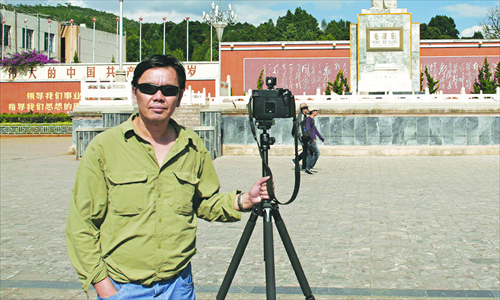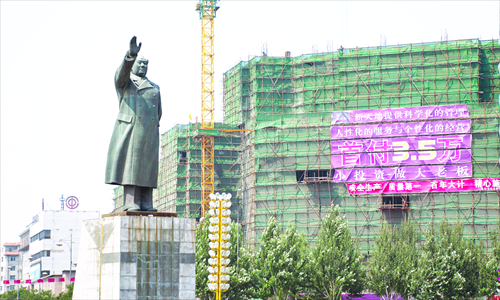In search of Mao

Cheng Wenjun with his camera in Lijiang, Yunnan Province. Photo: Courtesy of Cheng Wenjun
Wherever there is a statue of Chairman Mao in China, chances are, photographer Cheng Wenjun has been before, or plans to go in the future - in his quest to capture every sculpture of the country's most well-known leader through his very own lens.
It is an ambitious task, considering that after nearly 16 years and countless visits to most of the country's provinces, the 47-year-old has just scratched the surface - taking pictures of more than 200 statues, or roughly 10 percent of the estimated some 2,000 statues built of Mao during his reign, most of which are thought to have survived destruction in the post-Mao years.
Still, it is a sizeable collection of photos that has taken some time to develop, one that he shares through his picture book Searching, in a rendition of research published in January, which he describes as a history of "red sculpture." Years of research on Mao and endless hours scouring the country for the chairman's presence have led Shanghai-based Cheng, a native of Beijing, plenty of time to think about the subject of his photographs.
"Mao is great figure because he founded China," he told the Global Times. "But, he also made some mistakes."
'Coming alive'
Just a tiny baby when the Cultural Revolution (1967-77) began, Cheng has no memories of the turmoil, when a majority of the sculptures he shot, or 180 of them, were built. But his parents, like many others from their generation, have not forgotten the dark hours, which makes it so hard for them to support Cheng's work on Mao, an act they see as "too sensitive a remnant of the Cultural Revolution."
But their concerns have not stopped Cheng from pursing his art. The freelance photographer, who earns a stable income through his management of a Chinese sculpture company, has seen it all on his cross-country journeys in search of Mao statues.
He was on holiday in Kashi, a remote area of Xinjiang Uyghur Autonomous Region in 1989, when he was first shocked by a giant 24-meter-tall statue of Mao. Positioned in a public square covered in snow, it was crowded by local Uyghur people who sat by the man himself, chatting to one another as they basked in the winter sun. It was an unusual sight that piqued his interest for more.
He came across another massive Mao some years later in Sanya, Hainan Province, overlooking the sea along the coastline, and from then, the search was on. By 1997, Cheng captured his first Mao on camera in Zhangjiakou, Hebei Province, but did not take a serious approach back then as the project initially began as a fun hobby rather than an avenue for art.
"But then I started using the sculptures as references and I began magnifying the scope of the viewfinder to include people and surroundings into the photos to make the statues come alive," he said.
After opening a microblog on sina.com, asking people to help point him in the direction of more Mao statues, Cheng has traveled to almost every province and region in the country, taking tens of thousands of photos.
His personal Mao favorites include one in Nancun village of Linyin county in Henan Province, where the statue of the chairman is protected by two body guards; another in Jiangsu Province, which depicts Mao waving to the people in a village, where residents were relocated from some time ago; and one of Mao at a factory in Heilongjiang Province. The latter, made of stainless steel, is the only one of its kind nationwide and was created to represent the advancing steel-making skills at the time, said Cheng.
"Mao sculptures are mainly found in Henan, Hubei and Northeast China provinces, which used to enjoy strong economies during his time," said Cheng.
Yet ironically, the country's breakneck-speed development in recent years has given way to the demolishment of several statues, especially in more developed areas, such as Tianjin and Guangdong Province, where few statues of Mao still stand today.

One of the photography works of Cheng Wenjun, a Mao statue in Fuxin, Liaoning Province. Photo: Cheng Wenjun
Mao worship
But that hardly means that everyone is willing to let Mao go from their minds - and sights. It is not uncommon even these days to find people continuing to pay tribute to the chairman, by lighting firecrackers at his statues, or kowtowing to them as they pray for his blessing.
In fact, in Honghua county of Sichuan Province, local residents still sing revolutionary songs and light incense to mark March 16, 1968, the day that Mao visited - a decade before the statue was built to commemorate the leader.
"For some people, praying for the blessing of Chairman Mao is the equivalent of asking for blessings from God," said Cheng, who has admiration for Mao, but does not bow at his statues.
"Paying attention to Mao's sculptures is no different than focusing on the history of other sculptures or fine art, but people are not used to this because, before me, this was never done so systematically," said Cheng, adding that he has enjoyed taking pictures of Mao statues over the years.
Cheng said that his feelings on Mao, even after all these years, are complex and hard to describe in absolute terms.
"He is a giant in Chinese history, just like his bulky sculptures; both he and his sculptures are three-dimensional rather than just flat - or black and white," he said.
Though many supporters have marveled at Cheng's work, he has also had to deal with his critics who, like his parents, argue that his work reminds of the country's dark period under Mao and exposes people's pains and traumas from the era.
But Cheng disagrees, saying that he has a duty to continue uncovering more statues.
"History is history. People have to record it, face up to it and reflect upon it," he said. "We can't just pick and choose which parts of history to avoid…if anything it's more important now for us to take a retrospective approach and look back on what happened," he said.